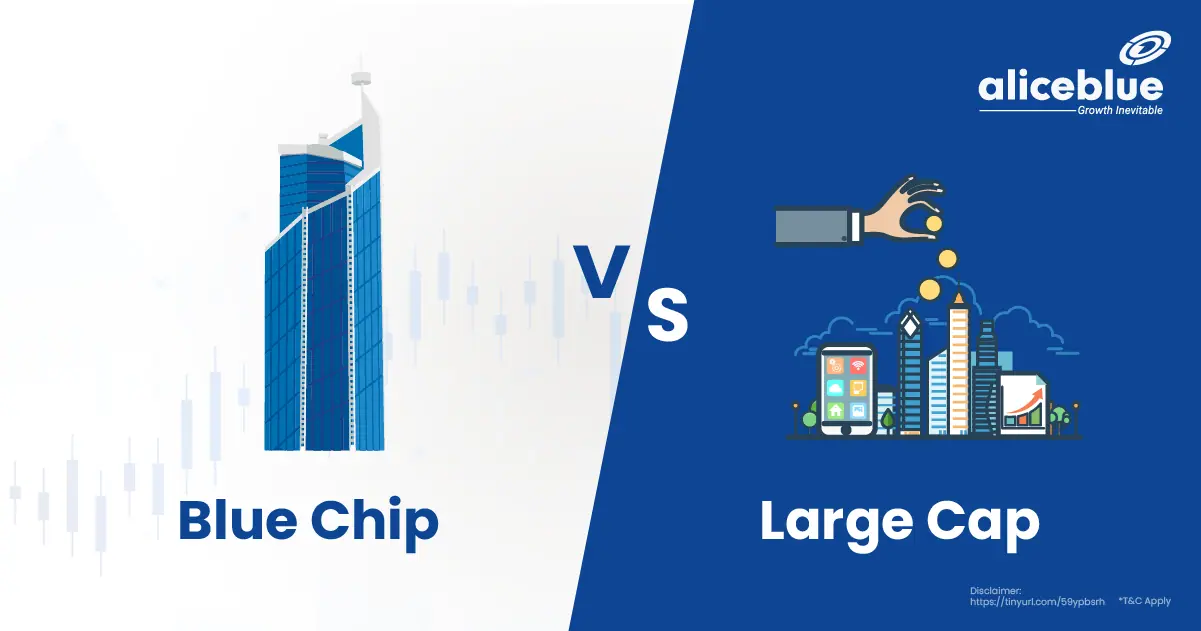The main difference between Blue Chip and Large Cap is that Blue Chip refers to companies with a reputation for reliability and the ability to operate profitably in good and bad times, while Large Cap refers to companies with a large market capitalization.
Content ID:
- Blue Chip Fund Meaning
- Large Cap Fund Meaning
- Blue Chip Stocks Vs Large Cap
- Blue Chip Fund Vs Large Cap – Quick Summary
- Difference Between Large Cap And Blue Chip – FAQs
Blue Chip Fund Meaning
A Blue Chip Fund invests in Blue Chip companies, known for their stability, reliability, and financial strength. These funds aim for steady returns with lower risk. Such companies are often well-established market leaders.
Blue Chip Funds focus on companies that are leaders in their industries, having a long history of performance and often paying dividends. These characteristics make Blue Chip Funds attractive for investors seeking less volatile investments. They prioritize long-term growth and stability, making them a preferred choice for conservative investors looking for a balance between safety and returns. Investors value these funds for their potential to provide stable and predictable financial growth over time.
Large Cap Fund Meaning
A Large Cap Fund invests in companies with a large market capitalization, considered to be the giants of their industries. These companies are usually well-established and financially sound, offering stable investment opportunities.
Large Cap Funds target businesses that rank at the top in terms of market capitalization, reflecting their size and stability in the market. Such investments tend to have lower volatility compared to smaller companies and can provide consistent returns. They are favored by investors who are looking for reliable growth prospects with a relatively lower risk profile, making them a cornerstone of many investment portfolios. These funds are particularly appealing to those looking to invest in the backbone of the economy, comprising firms that have a proven track record of resilience and performance.
Blue Chip Stocks Vs Large Cap
The main difference between Blue Chip stocks and Large Cap stocks is that, while all Blue Chip stocks are considered Large Cap due to their substantial market capitalization, not all Large Cap stocks are considered Blue Chip due to differences in performance history and reliability.
| Parameter | Blue Chip Stocks | Large Cap Stocks |
| Market Capitalization | Generally high, but not the sole criterion. | Defined by high market capitalization. |
| Performance History | Long history of stable performance and reliability. | Market cap is large, but performance may vary. |
| Dividend Payment | Often pay consistent dividends. | Dividend payment is less consistent. |
| Risk Profile | Lower risk due to stability and reliability. | Risk varies, generally lower than smaller caps. |
| Investment Appeal | Attractive for risk-averse investors seeking stability. | Appealing for those looking for growth with moderate risk. |
| Industry Leadership | Typically industry leaders with proven track records. | Sizeable market cap, but not necessarily industry leaders. |
| Investor Perception | Viewed as safe, long-term investments. | Seen as significant, but potentially less stable investments. |

Blue Chip Fund Vs Large Cap – Quick Summary
- The key difference between Blue Chip and Large Cap is that Blue Chip companies are known for their reliability and profitability in all market conditions, whereas Large Cap companies are defined by their large market capitalization.
- Blue Chip Funds invest in reputable companies known for stability and strength, aiming for steady returns and lower risk, making them attractive for risk-averse investors seeking stable growth.
- Large Cap Funds focus on industry giants with substantial market capitalization, offering stable and consistent returns with a lower risk profile, appealing to investors looking for reliable growth in well-established companies.
- The primary distinction between Blue Chip Stocks and Large Cap is that while all Blue Chip stocks fall under the Large Cap category due to their size, not every Large Cap stock qualifies as Blue Chip, highlighting a distinction based on performance history and reliability.
- Invest in stock market for free with Alice Blue.
Difference Between Large Cap And Blue Chip – FAQs
What Are The Difference Between Large Cap And Blue Chip?
The main difference is that all Blue Chip stocks are typically Large Cap due to their size, but not all Large Cap stocks are Blue Chip, as they might not share the same long-standing reputation for stability and performance.
What Is A Bluechip Fund?
A Bluechip Fund invests in Blue Chip companies, which are known for their reliability, financial strength, and long history of stable performance. These funds aim for steady returns with lower risk.
What Are Large-cap Stocks?
Large-cap stocks represent companies with large market capitalizations, typically in the billions, indicating that they are well-established players in their respective industries. They are known for their stability and consistent growth.
Is Nifty 50 A Large-cap Stock?
Nifty 50 is not a stock but an index representing the top 50 large-cap stocks listed on the National Stock Exchange of India, reflecting major sectors of the Indian economy.
Is It Safe To Invest In Bluechip?
Investing in Blue Chip stocks is considered safer compared to other stocks due to the company’s established record of reliability and consistent performance. It is making them suitable for the conservative investors.
Who Should Invest In Large-cap?
Investors who are looking for steady growth with a relatively lower risk profile should invest in large-cap stocks, as these companies are well-established, stable, and less volatile than smaller companies.
Why Is It Called Blue Chip?
The term “Blue Chip” comes from poker, where blue chips hold the highest value. In investing, it signifies companies with the highest value due to their stability, reliability, and financial strength.
We hope that you are clear about the topic. But there is more to learn and explore when it comes to the stock market, commodity and hence we bring you the important topics and areas that you should know:






